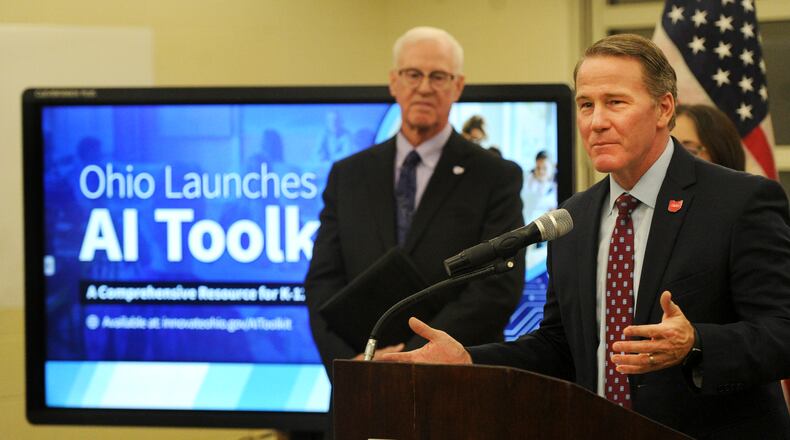“We want Ohio to be the dominant economic force in the Midwest,” Husted said Thursday in a visit to Northmont High School. “And to do that, we need talent.”
Husted stressed that Ohio schools do not have to use the toolkit or teach AI concepts, adding the resource is available for those who are interested.
The toolkit includes introductory material (what AI is and how it works); several examples of AI tools to explore; context on ethics issues surrounding AI use; plus classroom activities, hands-on challenges and a 10-week project-based learning course.
A sample activity shows students how an AI-powered tool can approve or deny a loan in 10 seconds based on 20,000 data points about the applicant. It asks students what data they would or wouldn’t be comfortable sharing with the app, why each data point is valuable, and how mass data collection could both benefit and harm app users.
“The most important, exciting and challenging moment to AI is that we don’t know what’s possible,” said Steve Dackin, director of the Ohio Department of Education and Workforce. “But the more tools we place in the hands of school leaders, educators, families and students, the better positioned we will be to use AI tools thoughtfully and responsibly.”
State officials said the toolkit addresses Ohio educators’ need to have trusted resources, as with any new subject matter. They want to prepare students to thrive in an AI-heavy world.
Northmont Schools Superintendent Tony Thomas noted that his district was an early adapter of AI for education.
Last fall, sophomore English teacher Erica Kempf had her students research AI and its implications. Kempf said she was initially wary of AI. But she created the research project, asking her students to craft research questions to guide projects and work in groups to answer questions about the impact of AI on the college application process, for special needs students, and more.
“Looking back on the experience of guiding students through this process, the biggest takeaway is the impact that having the opportunity to speak to policy makers had on my students’ learning,” Kempf said.
She said her students talked to the assistant superintendent at Northmont, college professors, and leaders from the technology and curriculum departments. Students came to class excited, she said, and she and her students brought articles to class for discussion.
“As a classroom teacher, it can be challenging to keep up with how rapidly technology changes around us, but it’s essential for our students that we are continuously willing to learn alongside them and be open to learning from them,” Kempf said.
Two of her students — Ayla Rammel and Samantha Jones — said the project brought them to see AI tools like Siri, Alexa and ChatGPT positively. Jones said she also found there was more than one way to use AI.
“There’s different classroom uses. It can help the parents, teachers, students, literally anyone,” Jones said. “And I think that’s really fascinating.”
Jerryl Briggs, who was also in Kempf’s class, said he still feels indifferent towards AI. But he said the project made him understand the implications better and see some of the positives as well as the negatives.
“I would say that I think AI can be very positive as long as the other cons are taken care of,” Briggs said, referencing misinformation as one of the potential negative sides of AI.
Husted said AI is being used already in a variety of different ways, such as on a dairy farm to figure out how much workers feed the cattle yields a return on milk production. There are implications for those who work at Wright-Patterson Air Force Base. A recycling center can use AI to sort items, while one person is running the robot.
“We help machines do more repetitive tasks in our lives and give us more enhanced opportunities to improve our efficiency and quality of life,” Husted said.
The toolkit was created in partnership with aiEDU, a nonprofit that helps build AI literacy.
About the Author

